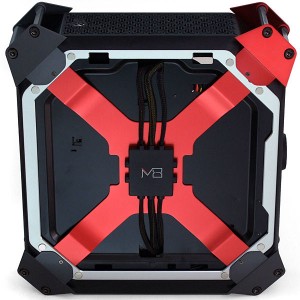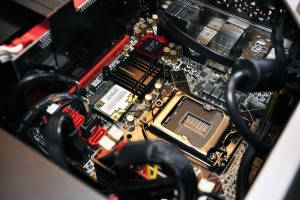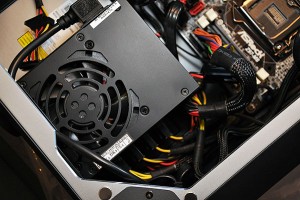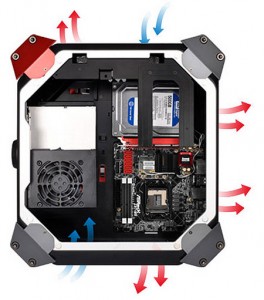As before, the M8 is a nice-looking enclosure. Its design is smartly thought out, which you might find unsurprising as BMW’s engineers had a hand in its creation. The case’s side panel is held on by magnets, rather than screws or latches. It has an octagon-shaped window in the center (chosen for its eight sides no doubt, playing into the product’s name). The chassis’ corners extend beyond the edge of the enclosure, each one featuring two crossbars 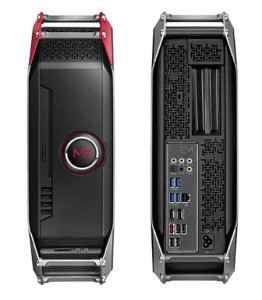 that function as feet when the M8 is positioned vertically. They also serve double duty as handles for easy transport. One of these is painted red so you know which way is up.
that function as feet when the M8 is positioned vertically. They also serve double duty as handles for easy transport. One of these is painted red so you know which way is up.
Up front, you’ll find a slot-loading DVD drive, four USB 3.0 ports and an LCD readout inside the large OLED button. It’s a unique look that fits in with an edgy home theater.
The case itself is primarily composed of billet aluminum. The side panel, case feet extensions and inner shell are made of the stuff. The outer shell is black polycarbonate, while the structure inside is a combination of steel and plastic. The aforementioned aluminum feet are held together with metal crossbars, which are fastened with large socket head bolts.
None of that is changed from the original version, so let’s take a closer look at what’s new.
Most notably, the chipset is updated to the latest LGA 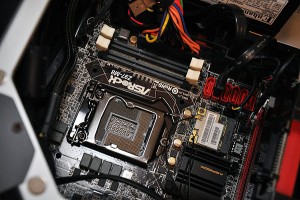 1150-oriented enthusiast model. While the original M8 came bundled with an ASRock Z87-M8 ITX motherboard, this version includes the updated Z97-M8. The board’s layout doesn’t change at all, though. You still get two SO-DIMM memory slots rather than full-size DIMMs. An 802.11ac wireless networking card still comes installed, and the onboard Sound Blaster audio solution is there as well. Really, it looks like the motherboard’s only evolution is Z97 Express.
1150-oriented enthusiast model. While the original M8 came bundled with an ASRock Z87-M8 ITX motherboard, this version includes the updated Z97-M8. The board’s layout doesn’t change at all, though. You still get two SO-DIMM memory slots rather than full-size DIMMs. An 802.11ac wireless networking card still comes installed, and the onboard Sound Blaster audio solution is there as well. Really, it looks like the motherboard’s only evolution is Z97 Express.




